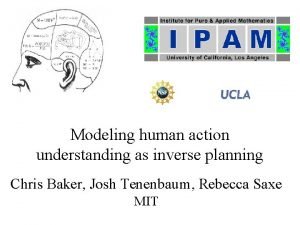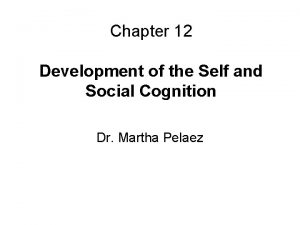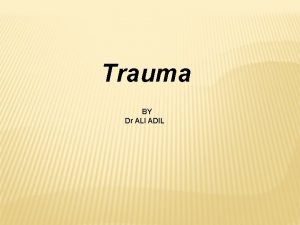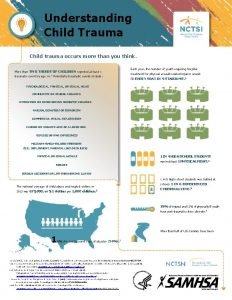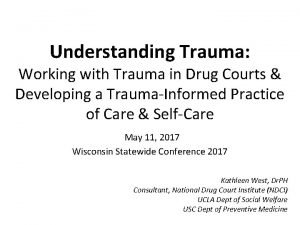Understanding trauma What is trauma A trauma is















- Slides: 15

Understanding trauma

What is trauma? A trauma is a psychologically distressing event that is outside the range of usual human experience. Trauma often involves a sense of intense fear, terror, and helplessness.

within its specific genetic potential, an individual’s brain develops capabilities suited for the ‘type’ of environment he or she is raised in. Simply stated, children reflect the world in which they are raised. .

• In the face of interpersonal trauma, all the systems of the social brain become shaped for offensive and defensive purposes. • A child growing up surrounded by trauma and unpredictability will only be able to develop neural systems and functional capabilities that reflect this disorganisation

If children are exposed to unmanageable stress, and if caregivers are unable to help them modulate their arousal they are unable to organise themselves physiologically and fail to categorise experiences in a coherent fashion… At the core of traumatic stress is a breakdown in the capacity to regulate internal states. ” Van der Kolk & Courtois, 2005

The way the child is stimulated and soothed shapes the brain’s neurobiological structure. What happens in the early years has a direct impact on the child’s capacity for living, learning and relating as a social being

Children exposed to con sistent, predictable, nurturing, and enriched experiences develop neurobiological capabilities that increase their chance for health, happiness, productivity, and creativity, while children exposed to neglectful, chaotic, and terrorizing environments have an increased risk of significant problems in all domains of functioning.

Effects of overproduction of stress hormone on child development These functions may be diminished or lost: § Ability to learn language and to speak § Understanding feelings or having words to describe them § Connection between emotion and sensory experience § Empathy § Control of impulse § Regulation of mood § Short term memory § Enjoyment

The Persisting Fear Response: Developmental Trauma. A child raised in an environment of chronic trauma (e. g. , domestic violence, physical abuse, community violence) will develop an excessively active and reactive stress response. Most stress response systems reside in the brainstem and midbrain. Overdevelopment of these areas, even in the presence of optimal emotional or cognitive experience, may lead to a predisposition to act in an aggressive, impulsive, behaviourally reactive fashion. Child Trauma Academy

Developmental Neglect: Emotional or Experiential Deprivation If key experiences are minimal or absent then poor regulation of impulsivity can occur and immature emotional and behavioural functioning may persist. The ability of the maturing brain to modify impulsive and reactive responses in the face of stress or frustration is decreased in individuals deprived of specific developmental experiences. Child Trauma Academy

Neglect and Trauma: The Malignant Combination Emotional and cognitive neglect often occur in combination with traumatic stress. The combination of a lack of critical emotional experiences and persisting traumatic stress leads to a dramatic alteration in the brain’s modulation and regulation capacity. An overdevelopment of lower brain functions (e. g. , anxiety, impulsivity, poor affect regulation, motor hyperactivity) and an underdevelopment of higher brain functions (e. g. , empathy, problem solving skills) increases the risk of emotional and psychological problems including violent behaviour. Child Trauma Academy

The CT scan on the left is an image from a healthy three year old with an average head size. The image on the right is from a three year old child suffering from severe sensory-deprivation neglect. This child's brain is significantly smaller than average and has abnormal development of cortex. These images are from studies conducted by a team of researchers from the Child Trauma Academy led by Bruce D. Perry, M. D. , Ph. D.

the most complex, severe and persistent disorders after trauma are those that follow traumatic experience in the first decade of life

What helps spontaneous recovery from trauma? • • Supportive attuned carer Previous positive experience Healthy coping skills Early help to process the experience

What impedes spontaneous recovery from trauma? • Repeated or chronic trauma • Actual injury of the child or someone significant to them • Caregiver also traumatised • Trauma caused by family member or other caregiver
 Understanding earth 5th edition
Understanding earth 5th edition Practical understanding
Practical understanding Cisco mesh ethernet bridging
Cisco mesh ethernet bridging Economics chapter 4 section 1 understanding demand answers
Economics chapter 4 section 1 understanding demand answers Insights and understanding ecclesiology
Insights and understanding ecclesiology Simple object access protocol
Simple object access protocol Sol writing rubric
Sol writing rubric Higher modern studies understanding standards
Higher modern studies understanding standards Understanding different business forms
Understanding different business forms Element of a computer system
Element of a computer system Action understanding as inverse planning
Action understanding as inverse planning Understanding text structure
Understanding text structure Development of self and social understanding
Development of self and social understanding National integration and international understanding
National integration and international understanding Understanding standards pe
Understanding standards pe Understanding science lesson 1 answer key
Understanding science lesson 1 answer key










